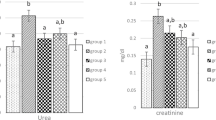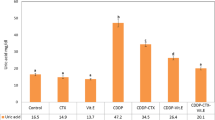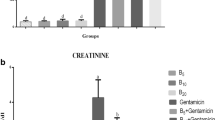Abstract
Gentamicin remains the mainstay in treatment of gram-negative infections, despite its potential ototoxicity and nephrotoxicity. In this study, we investigated dose-related protecting effects of vitamin C against gentamicin-induced rat nephrotoxicity. Hence, 50 male albino Wistar rats were randomly divided into five equal groups to receive a corresponding dose of either normal saline as control, vitamin C (200 mg/kg/bw, i.m.) or gentamicin alone (80 mg/kg/bw, i.m.) or in combination with vitamin C at low dose (200 mg/kg/bw, i.m.; LVG) and high dose (600 mg/kg/bw, i.m.) for 9 days. Daily administration of gentamicin at a dose of 80 mg/kg resulted in a significant increase in oxidative stress in renal tissues and plasma and a concomitant decrease in the creatinine clearance and renal blood flow as result of early hemodynamic toxicity. Histopathological examinations revealed acute tubular necrosis with hyaline cast formation triggered by gentamicin over 9 days of experiment, in addition to interstitial nephritis and tubular epithelial loss. Further biochemical studies showed protecting effects of supplemented vitamin C at a high dose, including slowdown in the urinary enzyme activity, a significant decrease in plasma lipid peroxidation, and an increased tissue superoxide dismutase activity with recovery in the glomerular hemodynamicity and the ATPase activity up to 50% when compared to controls and low-dose rats (LVG). In high-dose animals, normal glomerular and tubular function on recovery from toxic renal failure led us to conclude that antioxidant properties of vitamin C consistently increase with dose intensity. The present study also provided evidence that high dose of vitamin C prevented both functional and histological renal changes induced by gentamicin in rats, more efficient than low dose of the vitamin.







Similar content being viewed by others
References
Appenroth D, Frob S, Kersten L, Splinter FK, Winnefeld K (1997) Protective effects of vitamin E and C on cisplatin nephrotoxicity in developing rats. Arch Toxicol 71:677–683
Balakumara P, Rohillab A, Thangathirupathia A (2010) Gentamicin-induced nephrotoxicity: do we have a promising therapeutic approach to blunt it? Pharmacol Res 62:179–186
Bernheim FM, Bernheim ML, Wilbur KM (1948) The reaction between TBA and the oxidation products of certain lipids. J Bio Chem 174:257–264
Brun C (1951) A rapid method for the determination of para-aminohippuric acid in kidney function tests. J Lab Clin Med 37:955–958
Chie Y, Kousei I, Izumi K, Toshiharu H (2004) Protective effect of fosfomycin on gentamicin-induced lipid peroxidation of rat renal tissue. Chem-Bio Interac 148:139–147
Cross JM, Donald AE, Nuttall SL, Deanfield JE, Woolfson RG, Mac Allister RJ (2003) Vitamin C improves resistance but not conduit artery endothelial function in patients with chronic renal failure. Kid Int 63:1433–1442
Derakhshanfar A, Bidadkosh A, Yazdi A (2008) Dopamine protects gentamicin early induced nephrotoxicity in Sprague–Dawley rats. Comp Clin Pathol 17:99–104
Edwards BD, Chalmers RJ, O’Driscoll JB, Mitchell DM, Smith JRJ, Lawson RSL, Testa HJ, Ballardie FW (1994) Angiotensin II as a risk factor for cyclosporin nephrotoxicity in patients with psoriasis. Clin Nephrol 41:350–356
Erdem A, Nimet G, Alp U, Türkan K, Kamer K (1999) The antioxidant action of N-acetylcysteine on gentamicin-induced acute tubular necrosis in rats. Turkey Gazi Med J 10:21–28
Fetoui H, Makni M, Mouldi Garoui E, Zeghal N (2009) Toxic effects of lambda-cyhalothrin, a synthetic pyrethroid pesticide, on the rat kidney: involvement of oxidative stress and protective role of ascorbic acid. Exp Toxicol Pathol. doi:10.1016/j.etp.004.200908
Ghaznavi R, Kadkhodaee M (2007) Comparative effects of selective and nonselective nitric oxide synthase inhibition in gentamicin-induced rat nephrotoxicity. Arch Toxicol 81:453–457
Greggi ALM, Darin JD, Bianchi MD (2000) Protective effects of vitamin C against cisplatin induced nephrotoxicity and lipid peroxidation in adult rats: a dose dependent study. Pharmacol Res 41:405–411
Hare RS (1950) Endogenous creatinine in serum and urine. Proc Soc Exp Biol Med 74:148–151
Kadkhodaee M, Khastar H, Faghihi M, Ghaznavi R, Zahmatkesh M (2005) Effects of co-supplementation of vitamins E and C on gentamicin-induced nephrotoxicity in rats. Exp Physiol 90:571–576
Kadkhodaee M, Khastar H, Arab HA, Ghaznavi R, Zahmatkesh M, Mahdavi-Mazdeh M (2007) Antioxidant vitamins preserve superoxide dismutase activities in gentamicin-induced nephrotoxicity. Transplant Proc 39:864–865
Kanter M, Coskun O, Armutcu F, Uz YH, Kizilay G (2005) Protective effects of vitamin C, alone or in combination with vitamin A, on endotoxin-induced oxidative renal tissue damage in rats. Tohoku J Exp Med 206:155–162
Kavutcu M, Canbolat O, Ozturk S, Olcay E, Ulutepe S, Ekinci C, Gokhun IH, Durak I (1996) Reduced enzymatic antioxidant defense mechanism in kidney tissues from gentamicin-treated guinea pigs: effects of vitamins E and C. Nephron 72:269–274
Khan SA, Priyamvada S, Farooq N, Khan S, Khan MW, Yusufi AN (2009) Protective effect of green tea extract on gentamicin-induced nephrotoxicity and oxidative damage in rat kidney. Pharmacol Res 59:254–262
Kumar JA, Agarwal S, Chatterjee SN (1986) Ultrasonic radiation induced lipid peroxidation in liposomal membrane. Radia Env Biophy 25:309–314
Luft FC, Evan AP (1980) Glomerular filtration barrier in aminoglycoside-induced nephrotoxic acute renal failure. Renal Physiol 3:265–271
Mc Cord JM, Fridovich I (1969) Superoxide dismutase. An enzymic function for erythrocuprein (hemocuprein). J Bio Chem 244:6049–6063
Neugarten J, Aynedjian HS, Bank N (1983) Role of tubular obstruction in acute renal failure due to gentamicin. Kid Int 24:330–335
Rossig L, Hoffmann J, Hugel B, Mallat Z, Haase A, Freyssinet J, Tedgui A, Aicher A, Zeiher A, Dimmeler S (2001) Vitamin C inhibits endothelial cell apoptosis in congestive heart failure. Circulation 104:2182–2187
Servais H, Jossin Y, Van Bambeke F, Tulkens PM, Mingeot-Leclercq MP (2006) Gentamicin causes apoptosis at low concentrations in renal LLC-PK1 cells subjected to electroporation. Antimicrob Agents Chemother 50:1213–1221
Wang Y, Mackenzie B, Tsukaguchi H (2000) Human vitamin C (l-ascorbic acid) transporter SVCT1 Bio. Biophy Res Comm 267:488–494
Wenzel U, Nickel A, Kuntz S, Daniel H (2004) Ascorbic acid suppresses drug-induced apoptosis in human colon cancer cells by scavenging mitochondrial superoxide anions. Carcinogenesis 25:703–712
Yokogoshi H, Mochizuki S, Takahata M, Quazi S, Yoshida A (1983) The hypercholesterolemic effect of caffeine-containing beverages and xanthine derivatives in rats. Nutr Rep Int 28:805–814
Author information
Authors and Affiliations
Corresponding author
Rights and permissions
About this article
Cite this article
Derakhshanfar, A., Roshanzamir, M. & Bidadkosh, A. Dose-related protecting effects of vitamin C in gentamicin-induced rat nephrotoxicity: a histopathologic and biochemical study. Comp Clin Pathol 22, 441–447 (2013). https://doi.org/10.1007/s00580-012-1430-9
Received:
Accepted:
Published:
Issue Date:
DOI: https://doi.org/10.1007/s00580-012-1430-9




